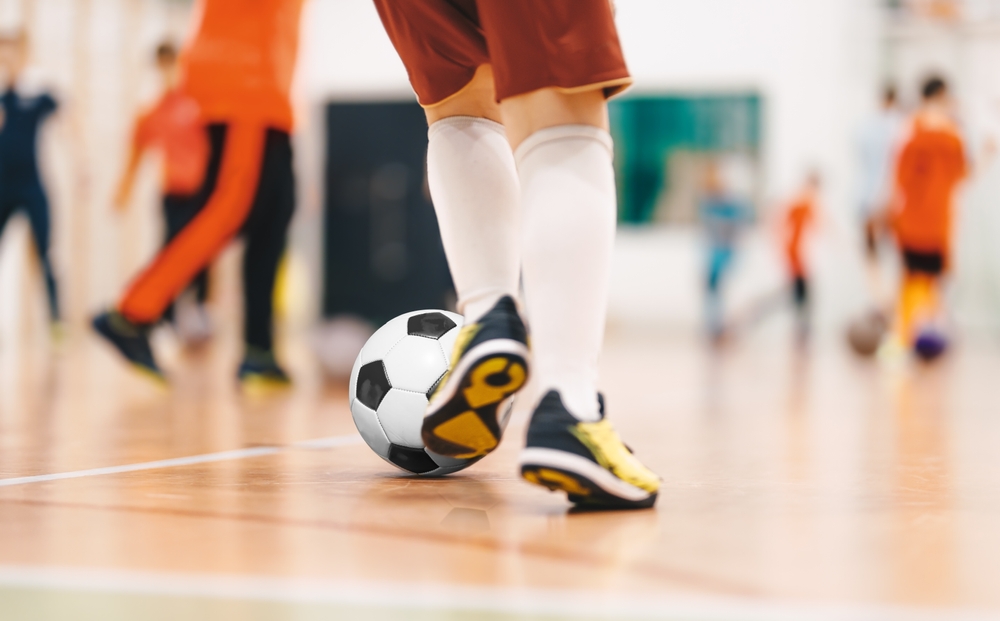The Tactical Renaissance of Futsal
A pulse-pounding indoor soccer match unfolds, players weaving through tight spaces with lightning-fast footwork. This isn't just any soccer game—it's futsal, a dynamic sport revolutionizing player development and tactical thinking across the globe. As traditional soccer grapples with evolving demands, futsal emerges as a catalyst for innovation, reshaping how we approach the beautiful game.

As the sport gained traction, it spread rapidly throughout South America, particularly in Brazil, where it became an integral part of youth development. The confined spaces and emphasis on ball control nurtured a generation of technically gifted players who would go on to dominate world football. Icons like Pelé, Zico, and Ronaldinho all credit futsal as a crucial element in honing their skills during their formative years.
The International Federation of Football Association (FIFA) recognized futsal’s potential and officially adopted it in 1989, standardizing rules and organizing world championships. This formal recognition propelled futsal onto the global stage, leading to its rapid expansion across Europe, Asia, and beyond. Today, futsal is played in over 100 countries, with professional leagues flourishing in nations like Spain, Portugal, and Russia.
The Unique Characteristics of Futsal: More Than Just Indoor Soccer
While often described as indoor soccer, futsal possesses distinct characteristics that set it apart from its outdoor counterpart. The most obvious difference lies in the playing surface and team size. Futsal is typically played on a hard court with five players per side, as opposed to the grass fields and eleven-a-side format of traditional soccer.
The ball used in futsal is smaller and heavier than a standard soccer ball, with less bounce. This design encourages players to keep the ball on the ground, promoting intricate passing and dribbling. The reduced playing area—roughly the size of a basketball court—necessitates quick thinking and precise ball control, as players have less time and space to make decisions.
Another key distinction is the absence of walls or boards surrounding the court. Unlike other indoor soccer variants, futsal is played with touchlines, similar to outdoor soccer. This rule prevents players from relying on bouncing the ball off walls and instead forces them to maintain possession through skill and teamwork.
The game’s structure also differs significantly. Futsal matches consist of two 20-minute periods of stopped clock time, meaning the clock is paused during stoppages in play. This leads to a more intense, action-packed experience with less downtime. Additionally, there are no limits on substitutions, allowing teams to rotate players frequently and maintain a high tempo throughout the match.
Tactical Innovations: How Futsal is Reshaping Soccer Strategy
Futsal’s unique constraints have given rise to a wealth of tactical innovations that are increasingly influencing traditional soccer. The limited space and constant pressure in futsal demand quick decision-making and precise execution, fostering a style of play that prioritizes technical skill and tactical awareness.
One of the most significant tactical developments to emerge from futsal is the concept of “pivot play.” In futsal, the pivot is a central attacking player who serves as a focal point for the team’s offensive strategy. This player often plays with their back to goal, using their body to shield the ball from defenders while teammates make runs into space. This tactic has been adapted in outdoor soccer, particularly in teams that employ a false nine or utilize strikers in a more creative, linking role.
The need for rapid transitions in futsal has also influenced modern soccer tactics. With the game constantly shifting between attack and defense, futsal players must be adept at both aspects of the game. This has led to the development of more versatile players and tactical systems that emphasize quick positional interchanges and fluid formations. Top soccer coaches like Pep Guardiola and Jürgen Klopp have incorporated elements of this fluidity into their tactics, creating systems where players constantly rotate positions to create space and confuse opponents.
Futsal’s emphasis on maintaining possession in tight spaces has also had a profound impact on soccer strategy. The “rondo” training exercise, now ubiquitous in soccer practice sessions worldwide, has its roots in futsal. This drill, which involves a small group of players trying to keep the ball away from one or two defenders in a confined area, hones the quick passing and movement essential in both futsal and modern soccer.
The Futsal Advantage: Enhancing Player Development
The tactical innovations fostered by futsal extend beyond strategy, profoundly impacting player development. The sport’s intense, skill-focused nature provides a unique environment for young players to hone their abilities, offering several key advantages over traditional soccer training methods.
Firstly, the confined space of a futsal court forces players to develop superior ball control and dribbling skills. With less room to maneuver and constant pressure from opponents, players must learn to manipulate the ball with precision and creativity. This translates directly to outdoor soccer, where players with futsal experience often exhibit exceptional close control and the ability to operate effectively in tight spaces.
The smaller, heavier futsal ball also contributes to skill development. Its reduced bounce and greater weight require players to use different parts of their foot for control, leading to improved touch and ball mastery. Many professional soccer players who began with futsal, such as Cristiano Ronaldo and Lionel Messi, are renowned for their exceptional ball control and dribbling abilities.
Futsal also accelerates decision-making skills. The rapid pace of the game, combined with the constant proximity of opponents, means players must think and act quickly. This mental agility translates well to outdoor soccer, where players who have futsal experience often demonstrate superior situational awareness and faster decision-making.
The sport’s structure, with its unlimited substitutions and intense bursts of play, also contributes to physical development. Futsal players develop excellent anaerobic fitness, quick acceleration, and the ability to change direction rapidly. These attributes are increasingly valuable in modern soccer, where high-pressing tactics and quick transitions dominate.
Futsal’s Global Impact: From Grassroots to Elite Levels
As awareness of futsal’s benefits grows, its influence is being felt at all levels of soccer, from grassroots development to elite competition. Many national soccer associations have recognized futsal’s potential and are integrating it into their youth development programs.
In Spain, for example, futsal is a compulsory part of youth soccer education. The Spanish Football Federation mandates that all youth teams play futsal during the winter months, believing it crucial for technical development. This approach has contributed to Spain’s success in both futsal and soccer, with the country consistently producing technically gifted players.
Brazil, long a powerhouse in both futsal and soccer, has always recognized the symbiotic relationship between the two sports. The country’s success in developing world-class players is often attributed to the prevalence of futsal in youth development. Brazilian soccer academies routinely incorporate futsal training, recognizing its value in nurturing creativity and technical skills.
At the elite level, many top soccer clubs now maintain professional futsal teams. Barcelona, for instance, has a highly successful futsal team that competes in Spain’s top futsal league. This integration allows for cross-pollination of ideas and tactics between the two sports, further driving innovation.
The influence of futsal is also evident in the evolution of soccer training methods. Many professional soccer teams now incorporate futsal-style drills and small-sided games into their training regimens. These exercises, conducted in confined spaces with limited players, simulate the intense, skill-focused nature of futsal, helping players improve their technique and decision-making under pressure.
Challenges and Future Prospects for Futsal
Despite its growing influence and popularity, futsal faces several challenges as it continues to evolve. One of the primary obstacles is the lack of widespread media coverage and commercial investment compared to traditional soccer. While futsal has a dedicated following, it still struggles to attract the same level of attention and financial backing as its outdoor counterpart.
Infrastructure is another significant challenge. Many countries lack adequate facilities for futsal, particularly at the grassroots level. The sport requires specialized courts and equipment, which can be costly to install and maintain. This lack of infrastructure can hinder the sport’s growth and limit opportunities for participation, especially in less economically developed regions.
There’s also the challenge of perception. In some circles, futsal is still viewed as a mere training tool for soccer rather than a legitimate sport in its own right. Overcoming this perception and establishing futsal as a distinct and valuable discipline is crucial for its continued growth and development.
However, the future prospects for futsal remain bright. The sport’s inherent excitement, skill focus, and adaptability to urban environments make it well-suited to modern sporting trends. As urbanization continues globally, futsal’s compact nature could make it an increasingly attractive option for cities with limited space for full-sized soccer fields.
The growing recognition of futsal’s benefits for player development is also likely to drive its expansion. As more soccer associations and clubs integrate futsal into their training programs, its profile and popularity are set to rise. This increased exposure could lead to greater commercial opportunities and media coverage, addressing some of the current challenges facing the sport.
The Fusion of Futsal and Soccer: A New Era of Tactical Innovation
As futsal continues to gain prominence, we’re witnessing an exciting era of cross-pollination between futsal and traditional soccer. This fusion is giving rise to new tactical approaches and training methodologies that are reshaping how we think about and play both sports.
One area where this fusion is particularly evident is in the development of hybrid playing styles. Some soccer teams are adopting futsal-inspired tactics, such as the use of a ‘pivot’ player or implementing more aggressive pressing strategies. These approaches, born from the intense, space-constrained nature of futsal, are proving effective in creating chances and disrupting opponents in outdoor soccer.
Conversely, futsal is also borrowing elements from outdoor soccer. Some futsal teams are experimenting with more expansive playing styles, utilizing the full width of the court in a manner reminiscent of how soccer teams use the flanks. This cross-adaptation is leading to a rich tapestry of tactical variations in both sports, providing coaches and players with an expanded toolkit for match strategy.
The fusion is also evident in player development pathways. Increasingly, young players are being encouraged to play both futsal and soccer, with the understanding that skills developed in one sport complement and enhance performance in the other. This dual-sport approach is creating a new generation of players with a diverse skill set, capable of adapting to various playing conditions and tactical systems.
The Role of Technology in Futsal’s Evolution
As with many modern sports, technology is playing an increasingly significant role in futsal’s development. From training aids to match analysis tools, technological innovations are helping to push the boundaries of what’s possible in the sport.
One area where technology is making a significant impact is in performance analysis. Advanced tracking systems, similar to those used in top-level soccer, are being adapted for futsal. These systems can provide detailed data on player movements, ball possession, and team formations, offering coaches and analysts unprecedented insights into game dynamics.
Virtual reality (VR) and augmented reality (AR) technologies are also finding applications in futsal training. These tools can simulate match scenarios and decision-making situations, allowing players to hone their tactical awareness and reaction times in a controlled environment. As these technologies become more sophisticated and accessible, they could revolutionize how futsal skills are taught and practiced.
Another technological frontier is in equipment design. Advances in materials science are leading to the development of futsal shoes and balls with enhanced performance characteristics. For instance, new ball designs are exploring ways to optimize the balance between control and speed, potentially altering the dynamics of the game.
Futsal’s Social Impact: Beyond the Court
While much of the focus on futsal centers on its sporting aspects, it’s important to recognize the broader social impact the sport is having, particularly in urban communities. Futsal’s accessibility—requiring only a small area and minimal equipment—makes it an ideal vehicle for social development programs in densely populated areas.
In many cities around the world, futsal programs are being used as a tool for youth engagement, providing a positive outlet for energy and a platform for teaching valuable life skills. The sport’s emphasis on teamwork, quick thinking, and adaptability translates well to real-world scenarios, helping participants develop skills that are valuable both on and off the court.
Futsal is also proving to be an effective means of promoting social inclusion. Its small-sided nature means that it’s easier to organize inclusive games that bring together people of different ages, genders, and skill levels. This inclusivity is helping to break down social barriers and foster community cohesion in diverse urban environments.
Furthermore, the sport’s growing profile is creating new economic opportunities in communities where it’s popular. From coaching roles to facility management, futsal is generating jobs and stimulating local economies, particularly in areas where traditional employment opportunities may be limited.
The Psychological Dimension of Futsal
An often-overlooked aspect of futsal’s impact is its psychological dimension. The intense, fast-paced nature of the game places unique mental demands on players, fostering psychological skills that are valuable both in sports and in life.
One key psychological attribute developed through futsal is rapid decision-making under pressure. The confined space and constant opponent pressure mean players must make split-second decisions continuously throughout a match. This not only improves on-court performance but also enhances general cognitive flexibility and mental agility.
Futsal also cultivates resilience and adaptability. The rapid shifts between attack and defense, and the need to quickly recover from mistakes (as goals can be scored in seconds), teach players to stay focused and bounce back from setbacks. These are invaluable skills that translate well to other areas of life.
The sport’s emphasis on teamwork and communication in tight spaces also fosters strong interpersonal skills. Players must constantly communicate, both verbally and non-verbally, to coordinate their movements and strategies. This develops social intelligence and the ability to work effectively in close-knit teams.
Moreover, the creative problem-solving required in futsal—finding ways to break through tight defenses or create space where there seems to be none—nurtures innovative thinking. This creativity, honed on the futsal court, can translate into enhanced problem-solving abilities in academic, professional, and personal contexts.
Futsal and Gender Equality in Sports
Futsal is also playing a significant role in advancing gender equality in sports. The sport’s accessibility and less physically imposing nature (compared to full-field soccer) make it an attractive option for female athletes, helping to break down some of the traditional barriers to women’s participation in team sports.
Many countries are seeing a surge in women’s futsal participation, both at grassroots and competitive levels. This growth is not only providing more opportunities for female athletes but also challenging gender stereotypes in sports. The technical skills and tactical understanding required in futsal showcase that success in the sport is not solely dependent on physical attributes, but on skill, intelligence, and teamwork—attributes not limited by gender.
Furthermore, the development of professional women’s futsal leagues in countries like Spain, Russia, and Brazil is creating new career pathways for female athletes. These leagues are not only providing competitive opportunities but also increasing the visibility of women in sports, inspiring the next generation of female futsal players.
The mixed-gender nature of many recreational futsal games and youth programs is also contributing to gender equality. By playing together from a young age, boys and girls learn to respect each other’s abilities and see each other as equals on the court, potentially influencing attitudes towards gender equality more broadly.
Environmental Considerations: Futsal’s Eco-Friendly Potential
In an era of increasing environmental consciousness, futsal’s compact nature and minimal equipment requirements position it as a potentially eco-friendly sport option. Unlike full-field soccer, which requires large, resource-intensive grass pitches, futsal can be played on existing hard surfaces, often indoors.
This adaptability reduces the need for water-intensive field maintenance and eliminates the use of potentially harmful pesticides and fertilizers often associated with grass pitch upkeep. Indoor futsal facilities can also be more energy-efficient, with better control over lighting and climate conditions compared to large outdoor stadiums.
Moreover, futsal’s popularity in urban areas can contribute to more sustainable city planning. By providing a space-efficient option for sports facilities in dense urban environments, futsal courts can be integrated into multi-use community spaces, promoting efficient land use and reducing the need for transportation to distant sports grounds.
The sport’s minimal equipment needs—essentially just a ball and flat surface—also mean a lower environmental impact in terms of manufacturing and disposal of sporting goods. This simplicity aligns well with growing consumer trends towards minimalism and sustainability in sports and recreation.
Futsal in the Digital Age: Online Communities and E-sports
The digital revolution is not leaving futsal behind. The sport is finding new expressions and communities in the online world, expanding its reach and influence beyond physical courts.
Online futsal communities are flourishing, with players, coaches, and fans connecting through social media platforms, forums, and dedicated websites. These digital spaces serve as hubs for sharing tactics, training tips, and match highlights, fostering a global futsal culture that transcends geographical boundaries.
Video sharing platforms have become particularly important for futsal’s growth. Spectacular goals, skills, and tactical moves can now be shared instantly with a global audience, raising the sport’s profile and inspiring new players to take up the game.
The rise of e-sports is also touching futsal. While not as prominent as soccer in the gaming world, futsal-specific video games are emerging, offering a new way for fans to engage with the sport. These games not only provide entertainment but also serve as tools for understanding tactical concepts and player movements, potentially enhancing real-world play.
Live streaming of futsal matches is becoming more common, allowing fans to watch games from around the world. This increased accessibility is crucial for the sport’s growth, exposing more people to high-level futsal and potentially driving participation and fan engagement.
The Educational Potential of Futsal
Beyond its sporting merits, futsal is increasingly being recognized for its educational potential. The sport’s emphasis





